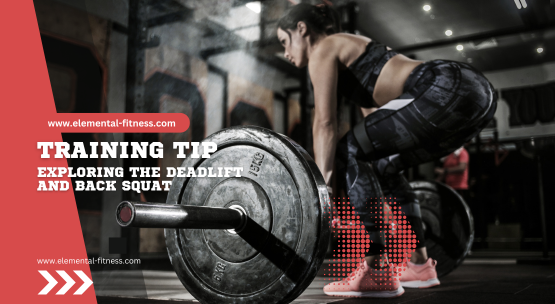
Exploring the Deadlift and Back Squat
Training Offered
- Join Today
- Our Personal Trainers
- Face To Face Personal Training Leeds
- Your First Session
- Online Training Leeds
- Remote Personal Training Leeds
- Ladies Kickboxing Leeds
- Under 18S Fitness Leeds
- School Programmes
- Corporate Team Events
- Gym Space Hire Leeds
- Treatment & Therapy Hire
- Gym Access
- Covid-19 Rehabilitation
- Low Back Pain Treatment
- Boot Camps Leeds
- Food Intake & Nutrition
- Kickboxing Classes Leeds
- Personal Training Leeds Faqs
12
Jun
Exploring the Deadlift and Back Squat
By: Elemental Fitness daedlift, backsquat, personaltrainingleeds

Unlocking Strength: Exploring the Deadlift and Back Squat
Strength training is a cornerstone of fitness, and two exercises often found in the repertoire of gym-goers are the deadlift and back squat. While both are compound movements with the potential to build muscle and increase strength, they differ significantly in their execution and the muscles they target. Let's move into the specifics of each exercise to understand their unique benefits and applications.
The Deadlift
Muscles Targeted:
The deadlift is a powerhouse exercise that primarily engages the posterior chain, including the lower back, glutes, hamstrings, and traps. It's a full-body movement that also activates the core muscles, forearms, and grip strength.
Movement Pattern:
With a loaded barbell or weight in front of you, the deadlift begins with a hip hinge movement. You push your hips back while maintaining a flat back until you reach the barbell. Then, you lift the weight by extending your hips and knees, bringing your torso to an upright position.
Equipment:
To perform deadlifts, you'll need a barbell and weights or other forms of resistance, such as kettlebells or dumbbells.
Variations:
There are various deadlift variations to suit different goals and preferences, including conventional deadlifts, sumo deadlifts, Romanian deadlifts (RDLs), and stiff-leg deadlifts.
The Back Squat
Muscles Targeted:
Unlike the deadlift, which emphasises the posterior chain, the back squat primarily targets the lower body muscles. These include the quadriceps, hamstrings, glutes, and lower back, with the core muscles working to stabilise the body.
Movement Pattern:
The back squat involves lowering your body into a squat position with the barbell resting on your upper back and shoulders. You then drive back up to a standing position by extending your knees and hips.
Equipment:
Similar to the deadlift, the back squat requires a barbell and weights or other resistance equipment. Variations like goblet squats can be performed with dumbbells or kettlebells.
Variations:
Back squats offer several variations, including high-bar squats, low-bar squats, front squats, goblet squats, and overhead squats, each with its own emphasis and benefits.
Key Differences
Muscle Targeting: Deadlifts primarily target the posterior chain, while back squats focus more on the lower body muscles.
Movement Pattern: Deadlifts involve lifting weight from the ground with a hip hinge movement, while back squats involve lowering into a squat position and then standing back up.
Equipment: Both exercises require a barbell and weights, but variations and alternatives can use different equipment.
In conclusion, incorporating both deadlifts and back squats into your strength training routine can yield significant benefits. By understanding their differences and incorporating appropriate variations, you can tailor your workouts to target specific muscle groups and achieve your fitness goals effectively.


